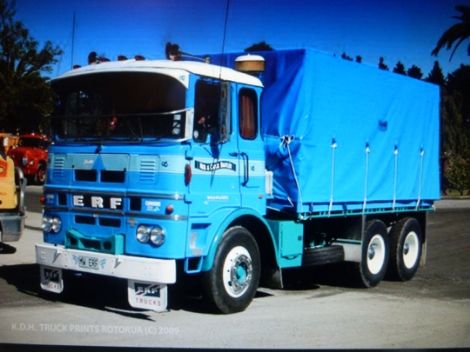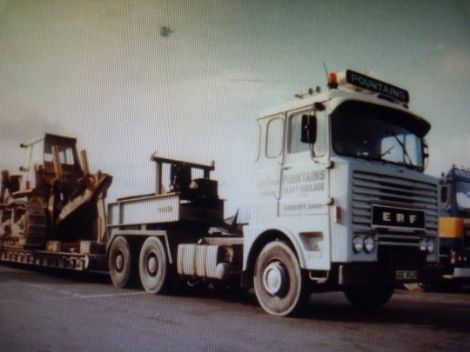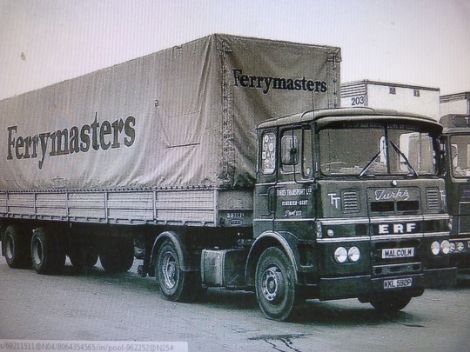Let me tell you about the time I got behind the wheel of one. The 6x4 NGC 420 (technically an NGC 422) was definitely my kind of truck and I was keen to find one still alive. To this end I visited Gary Corbishley to view his preserved example, one of the very rare 6x4 units and perhaps the last running NGC 420 of any kind in existence (though who knows what else might turn up in a barn one day). It left the factory as a 4x2 NGC 420 with the chassis no. 27371 in 1974 and went the ERF dealer, CDB (the Belgian ■■■■■■■ distributor) in Brussels. The vehicle was bought by a Belgian timber hauler called Marcel Eyckmans of Betekom, where it received its registration number 7DF 44 and a winch. Four years later the chassis was stretched and converted to double-drive using a Hendrickson bogie with Trilex wheels. This was transplanted from a White 6x4 unit. An impressive 30-tonne/metre, chassis-mounted Fassi crane was installed behind the cab, and was supported by a heavy sub-frame. The unit pulled a specialist pole-trailer for carrying round-timber until 1986 when it was carefully ‘moth-balled’ in a garage for seventeen years with the intention of preserving it. It was eventually sold on condition it would be preserved, to Rene Postma in Holland. The truck had only done 150,000 miles by this time, having spent twelve years working in the woods. By a stroke of luck, the Dutch transport historian, Wobbe Reitsma (who has an encyclopaedic knowledge of British trucks) became involved in the rescue operation and recorded its journey to Holland in some detail in his article, ‘Hefty European,’ in REVS magazine (the ERF preservation journal). It finally returned to Britain when the Corbishleys acquired the project and fitted the heavy-duty bumper assembly and ballast box, lovingly restoring it to its present high standard. This venerable vehicle now looms imposingly from the mists of time to appear at truck shows around the country re-registered as KCH 95N.
I was led into a workshop to be introduced to it. What a magnificent beast it was, resplendent in its blue and red livery and sporting those Trilex rear wheels — themselves a fabulous ‘period’ detail. Gary, very generously, let me drive it round the Corbishley premises so I was able to conduct the Trans Yard Test (rather than the Trans Euro Test). Naturally, I had breakfasted on Shredded Wheat - there used to be an ERF advert picturing a cereal bowl laden with ten pieces of Shredded Wheat, with the caption: ‘I bet he drives an ERF!’
I hauled myself into the Motor Panels cab using that long grab handle and the tread-plated step ring. As soon as I sat in the driver’s seat it felt entirely right, giving me the gratifying impression of sitting on top of the controls, rather than behind them. For a driver who hadn’t sat in a ‘70s ERF for many years, it felt like ‘coming home’. The starter was on the key, but set into the dashboard. When I fired her up the exhaust stack behind the cab gave voice to the ■■■■■■■ straight-six. Once the air had built up I floored the left pedal to engage the clutch-brake, slotted it into third in low-range, let in the clutch until the double drive wheels bit into the ground and the great legend eased gently into motion. The accelerator pedal was hinged to the floor, enabling me to squeeze smooth power from the NTC 335 engine, which was probably ■■■■■■■■■ best small-cam creation: powerful, uncomplicated and long-lasting; and it growled reassuringly as I pulled out of the workshop and into the yard. By the way, the N in NTC denotes a four-valve head, T stands for turbo and C stands for custom.
With my preference for left-hand-drive lorries, I found the driving position excellent and the flat steering wheel fell comfortably to hand. The power steering was satisfyingly stiff, giving exactly the right amount of positive resistance as I fed that distinctive three-spoke steering wheel through my hands. This steering wheel appears to have been fitted to nearly all NGC 420s in a uniform grey colour, though TRUCK magazine’s Trans Euro testers claimed that it obscured dials at times. Rather curiously, nothing whatsoever adorned the steering wheel boss, unlike other models which bore the ERF logo.
For me, the somewhat dated switchgear was all part of its endearing charm, but everything was there where I could see it. Additions to the dashboard were the power take-off switch and the diff-lock switch. The engine hump was unobtrusive for a lorry of the period, probably because the cab was so tall, and the cockpit had none of the cramped feeling of some other units of that time. Little niceties like bottle holders and storage holes were moulded into the engine cover. The bunk looked a little narrow by today’s standards but was normal in its day. I found the big clutch pedal surprisingly well assisted. It is easy to forget what good trucks we had in the ‘seventies: how sophisticated they were, how comfortable they were and what a pleasure they were to drive. The windscreen, with its impressive triple wipers, was not as deep as more modern trucks, but it was beautifully proportioned and I found the height and depth pleasing without compromising forward visibility. And it had quarter-light windows at the side for regulating fresh air: I miss those even now.
With its full width, tall cab it had certainly had that ‘big truck’ feel that most later tractive units had. In fact, the driver was perched higher from the ground than in the later B-series cab, and this shows clearly in photos which juxtapose the two models. A good example of this is a Van Steenbergen fleet line-up photo showing six NGC 420s and two B-series, to be found in ‘Transportnostalgie uit Belgie’, by Mario Maes.
This wonderful ERF was enormously satisfying to drive, even over the short distance round the premises and I was absolutely bowled over by it.Pat Kennett, editor of TRUCK magazine, author of ERF: World Trucks No. 1 and HGV tester claimed that theNGC 420 was ‘a great truck in sight, feel and sound’. Jerry Cooke of Trans Arabia agrees that they were superb to drive and Gary Corbishley certainly wouldn’t take KCH 95N to all those truck shows if he didn’t think so too.
On a subsequent visit, Gary took me for a drive round the Staffordshire countryside. It rode the old A-roads very well and it wasn’t difficult to imagine how stable it would be with a trailer. Of course it seemed noisy compared with modern trucks but the sound was worth listening to! Some of the noise was attributable to the permanently engaged fan. Later NGC 420s had Dynair fans which were thermostatically controlled and which were to prove very effective in Saudi Arabia. Visibility both forward and rearward was excellent. It was a most comfortable and enjoyable drive, made even more so by Gary’s skilful handling of the vehicle. Truck testers, both at home and abroad, praised theNGC 420’s handling characteristics — its suspension, steering, braking, acceleration, transmission and road-holding.
As mentioned earlier, most 335-powered NGC 420s came with a constant-mesh Fuller Road-Ranger 9-speed gearbox. However, as mentioned earlier, this particular vehicle was actually supplied new to Eyckmans with a Fuller RTO9513 13-speed gearbox and is itemised as such on the invoice.Reassuringly attached below the dashboard was the original 9-speed gear-shift diagram plate fitted on the production line. The 13-speed gear knob had been replaced by a Twin-splitter knob, which neatly gives the three positions required for gear selection thus making it easier for drivers like me, who prefer to make downward splits-shifts on older 13-speed ‘boxes by pre-selecting the lower split, moving the stick into neutral, double-declutching and returning the stick to its original position. Done habitually, this technique is relatively effortless, ensures cleaner and more reliable changes and is particularly satisfying to use when ascending steep hills or entering roundabouts.
Oddly enough, the driving position felt far more comfortable than I remember the B-series ever being, but I initially thought that it may have more to do with my small stature or that maybe it was because the seat squab wasn’t designed for the build of driver who appeared regularly in Truck & Driver magazine’s Shobba cartoons. However, I later learnt that I was by no means alone in my opinion. Wobbe Reitsma reports in his article (‘Flemish ERFS’, REVS magazine issue 68) that in Europe drivers generally preferred the NGC 420 to the left-hand-drive B-series, mainly because they were more comfortable (though it ought to be mentioned that operators preferred the more fuel-efficient B-series). Furthermore, a blogger on this thread called ‘Dave’ gave a fascinating account of an NGC 420 he drove, registered KRH 153P. It ran in the red and white livery of PG Horridge on TIR tilt work (I posted a picture of this earlier). Dave later drove a LHD ERF B-series (BMB 447W) for Phil Horridge but he claimed that it ‘wasn’t a patch’ on the old NGC 420 he drove before progressing to the B-series. Dave described how he could drop a gear in the 7MW at 60 mph to get out of trouble, something he couldn’t do in the B-series. He also mentioned that the NGC 420 would ‘pass anything going up Cherbourg hill’ — the steep climb out of the port. Clearly, he rated the formidable performance of the ‘big banger’ ■■■■■■■ 335 coupled to a 9-speed Fuller in the NGC 420 more highly than its successor.
Having reversed the old girl onto a patch of grass at the bottom of the track after my ‘trans yard test’, I rested my hands on the wheel momentarily to reflect upon Eric Vick’s Middle-East drivers who once sat, as I did now, at the wheel of an NGC 420 unit loading for the Gulf. And I closed my eyes to rekindle that wonderful, ‘heading south’ feeling that explodes in the pit of the stomach when you fire up a lorry bound for the Orient. Robert:)








 NGC 420s on long-haul work, including Middle-East traffic, had to pass through mainland Europe. Driving on The Continent was significantly different when ‘seventies ERFs disembarked at Calais. For drivers, each country had its own very distinctive atmosphere to a far greater extent than today. Part of this was because the old ‘nationals’ ran through all the towns and villages, so drivers got a real flavour of each country. The truck stops had their own distinctive character too: the autohofs of Germany, the hostals of Spain and of course Les Routiers in France. Even the currencies were different. Rules and regulations were more diverse and yet to be homogenized by the EU. About the only thing not to have changed is the variety of languages. Most of the really exciting roads have been ironed out or by-passed altogether: the Route Nationale 10 in France, for example, has changed beyond all recognition from a challenging truckers’ trunk route into a bland, safe dual-carriageway which by-passes all the towns and villages. The pace of life was more measured and an NGC 420 driver was never tyrannized by the mobile phone, just-in-time deliveries or the Health and Safety Executive. The engine would even start when the driver wasn’t wearing a high-viz vest and steel-capped boots! It ought to be remembered that one of the reasons for the pace of life being slower was because European countries still had border controls. Running the gauntlet of the more corrupt customs and excise officials and traffic police was one of the downsides of driving life until the EU border controls were relaxed. Driving on The Continent was, and still is, a way of life and depending on the outlook of the driver; his NGC 420 was either an evil juggernaut designed for blasting milk bottles off doorsteps in the middle of the night, or it was a natty air-conditioned two-seater tourer, designed for driving on Le Continent. Robert
NGC 420s on long-haul work, including Middle-East traffic, had to pass through mainland Europe. Driving on The Continent was significantly different when ‘seventies ERFs disembarked at Calais. For drivers, each country had its own very distinctive atmosphere to a far greater extent than today. Part of this was because the old ‘nationals’ ran through all the towns and villages, so drivers got a real flavour of each country. The truck stops had their own distinctive character too: the autohofs of Germany, the hostals of Spain and of course Les Routiers in France. Even the currencies were different. Rules and regulations were more diverse and yet to be homogenized by the EU. About the only thing not to have changed is the variety of languages. Most of the really exciting roads have been ironed out or by-passed altogether: the Route Nationale 10 in France, for example, has changed beyond all recognition from a challenging truckers’ trunk route into a bland, safe dual-carriageway which by-passes all the towns and villages. The pace of life was more measured and an NGC 420 driver was never tyrannized by the mobile phone, just-in-time deliveries or the Health and Safety Executive. The engine would even start when the driver wasn’t wearing a high-viz vest and steel-capped boots! It ought to be remembered that one of the reasons for the pace of life being slower was because European countries still had border controls. Running the gauntlet of the more corrupt customs and excise officials and traffic police was one of the downsides of driving life until the EU border controls were relaxed. Driving on The Continent was, and still is, a way of life and depending on the outlook of the driver; his NGC 420 was either an evil juggernaut designed for blasting milk bottles off doorsteps in the middle of the night, or it was a natty air-conditioned two-seater tourer, designed for driving on Le Continent. Robert




